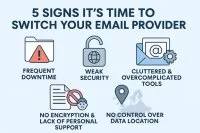
The best way to describe this is that an email alias functions as a virtual forwarding address, directing messages sent to the alias to your primary email inbox. Think of it as an alternative identity that enables you to use distinct email addresses for various purposes without the need to create separate accounts. This means that when someone sends an email to your alias address, it seamlessly redirects to your primary inbox, ensuring a more organized communication experience.
Creating an email alias is a straightforward process that varies depending on your email provider. Generally, you can set up aliases through your account settings. Select a unique and identifiable alias name, and associate it with your primary email address. Once established, you can utilize this alias for different purposes, consolidating all communication in one central location.
Email aliases offer an added layer of privacy, as you can use different aliases for various online activities without disclosing your primary email. Additionally, aliases enable you to categorize incoming messages effectively, promoting a more organized and manageable inbox. If an alias starts receiving spam, you can deactivate it without impacting your primary email.
It is crucial to distinguish between email aliases and forwarding addresses. An email alias forwards messages to your primary inbox, consolidating all communications in one place. On the other hand, a forwarding address sends emails to a different email account altogether, effectively separating email communications. By using aliases, you maintain centralized control over your messages, while forwarding addresses create separate destinations for incoming emails.
It is undeniable that effectively managing multiple email aliases involves implementing a few strategies. Select descriptive aliases that reflect their intended purposes, making it easier to identify their uses. Organize incoming emails into appropriate folders based on the alias destination to maintain an orderly inbox. Periodically review and manage your list of aliases to remove any unused or unnecessary ones, ensuring an uncluttered email experience.
When it comes to protectibg, Email aliases can bolster your online security by reducing the exposure of your primary email address. By using aliases for different purposes, you can minimize the risk of your primary email becoming a target for spam or potential security breaches.
Undoudtedly, email aliases offer numerous benefits, howerever it is essential to be aware of potential drawbacks. Certain email providers may charge additional fees for alias features, so it's prudent to confirm any associated costs. Additionally, while aliases provide privacy benefits, they may not entirely eliminate spam, as spammers can still target individual aliases. E-mail aliases at EmailReseller are free of charge.
Just as it happens with any technical feature, email aliases may encounter occasional issues. If you encounter any problems with alias forwarding or delivery, consult your email provider's support resources for guidance. In most cases, common issues can be resolved through straightforward troubleshooting steps.
There are numerous email clients offer robust support for email aliases, making the adoption of aliases seamless. Providers such as EmailReseller, Gmail, Outlook, and ProtonMail are widely recognized for their compatibility with alias functionality, empowering users to manage their email communications effectively.
To optimize the use of email aliases, adhere to these practices:
The use of email aliases is always worth considering and it can be a truly powerful and reliable way to upgrade security on the web.
![]() © 2022 - 2025 HostingBe.com Simple CMS versie 3.1.0
© 2022 - 2025 HostingBe.com Simple CMS versie 3.1.0